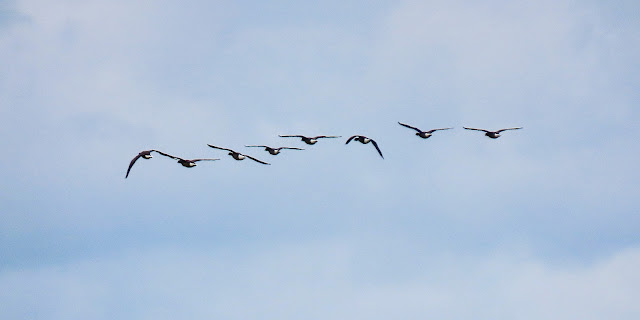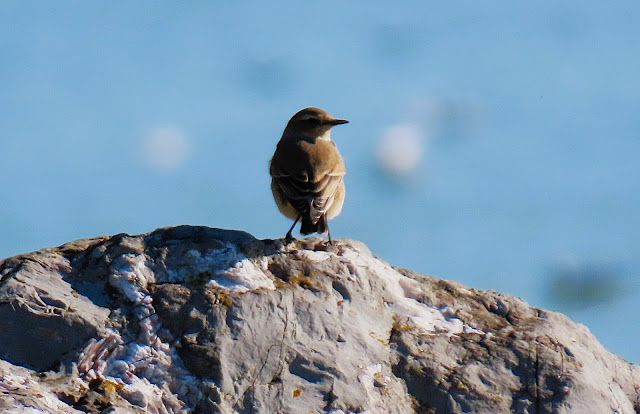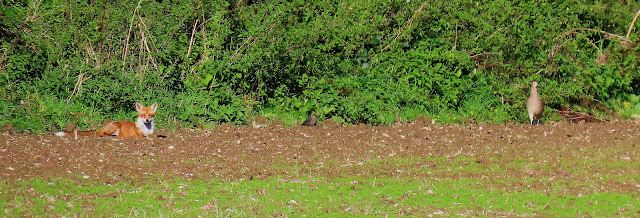Monday, 30th September: A wet and windy night with heavy rain and a near gale-force SW wind and continuing into the morning, before the wind veered more to the W force 6-7. Thereafter a very grey, wet and blustery day with the strong wind pushing through frequent bands of light rain and drizzle.
Elmer Rocks: What a difference a day makes! After the excitement of yesterday, today proved to be just the opposite, for me at least. Hopes were high as I arrived for a sea-watch (0815-1015hrs) but the persistent rain and high tide made it difficult to see beyond the rock islands for the first half-hour, then as things improved a bit I saw almost nothing! A small number of the regular Oystercatchers and Ringed Plovers flew along the beach and a single Gannet drifted W, whilst a forlorn Chiffchaff called from the wind-battered tamarisk bush behind me. There surely had to be something on the move after the stormy conditions last night, but in short there was just nothing I could see worthy of any further report....dreadful.

In the absence of any birdlife to photograph, these are the best I could come up with...... (above) a grey and stormy outlook with difficult viewing conditions and (below) whilst I'm not prone to taking selfies, this one says it all, as I huddle into a corner with my 'scope, sheltering from the driving rain under my broken umbrella....there are just times when I wonder why I do it!

Bilsham farm: Undaunted, I made a visit here just in case any storm-driven birds had sought shelter on the reservoir. However, the track to the site was basically a sea of liquid mud, having been used by tractors and vaguely reminiscent of the Somme, whilst the drizzly rain had now increased in the strong wind. There was nothing much of note to be found on the water; 147 Coots, six Little Grebes, a Gadwall, 10 Tufted Ducks and two Swallows were a meagre return for my effort. I was by now quite wet, a return march through the Somme did me no favours - and I came to a mature gentleman's decision that I'd had enough birding today, so home for lunch!
Sunday, 29th September: A mainly grey and cloudy day with a few glimpses of sun, but dominated by a brisk S/SE wind force 4, soon increasing to a very blustery 5-6.
Climping Gap: Funny how it goes sometimes. I set out this morning planning to do a good circuit of the fields and hedges searching for passerine migrants, but ended up with a totally unexpected seabird to brighten the day.
I soon realised the bushes were being battered by the wind, so it was necessary to seek out the sheltered spots, where I located up to six feeding Blackcaps and five Chiffchaffs, and then two Stonechats nearby. Half a dozen Skylarks were in the fields together with about 10 Meadow Pipits, but it was slow going, although there was a constant trickle of Swallows, and to a lesser extent House Martins, passing through heading eastwards....it was impossible to count them, but numbers would have been well into three figures. Other species seen included Sparrowhawk, Linnet (a flock of c.100) and Greenfinch, but with the wind now buffeting the open habitat, I decided to have a short look at the sea.
I hadn't actually planned a sea-watch today, but I managed to find a nice sheltered spot behind some tamarisk, then started scoping the horizon. There were some Gannets passing at distance, mostly heading west, but not much else except of number of gulls back and forth, including a few Mediterranean Gulls. I'd been there about 15 minutes and it was all very disappointing....but then, out of the blue (or perhaps I should say grey) it happened. At about 10:25hrs I was scanning the horizon through my scope, trying to count Gannets, when suddenly a distinctive dark-looking bird came into my field of view, but very much closer, looking very close in the scope. The distinctive shape and flight left no doubt - it was a shearwater, and it was close, very close for a shearwater. Almost disbelievingly, I tracked it as it continued west; initially considering Sooty, but I soon eliminated that due to wing length and size, plus some pale showing on the underparts.
I won't give a full description here, but suffice to say that I was satisfied I had eliminated Manx and Sooty Shearwaters and established it was in fact a Balearic Shearwater. This rare shearwater - if accepted by the relevant rarity committee - is a long overdue 'patch tick' and although the species does move offshore in the English Channel at this time of year, the chances of seeing one from our area are always slim, and especially at comparatively close range, due to our geographical position in the bay of Sussex, for headlands such as Selsey Bill are normally required. But it was certainly a 'wow' moment for me today!
I finished my sea-watch at 11:10 having logged a few more Gannets - including one which flew east along the beach and almost overhead - and a flock of eight Brent Geese east.
(above) Gannet east over the beach at Climping; I almost missed this bird until I looked up as it passed overhead - hence the hasty shot which is basically just a silhouette, and (below) Brent Geese heading west offshore - they are starting to return now for the winter.
Saturday, 28th September: A cold, clear night leading to a chilly but bright start, with a light N/NW breeze and a clear, sunny morning with a cloudless sky, although some cloud developing later.
Ancton: A Coal Tit was singing full pelt for a little while, moving around between gardens as it establishing a territory; as mentioned before this is not a common species in this area of the coast. A couple of Chiffchaffs were also in the area.
Elmer Rocks: A beautiful morning along the beach. Gannets were moving west at distance and during my occasional watches there were at least 30 passing through. The sea however was generally quiet, with only a few Mediterranean Gulls adding to the seabird interest and a few other seabirds too distant for identification. Along the beach and rock islands, at high tide, at least 32 Ringed Plovers were roosting, plus six Turnstones and 10 Oystercatchers.
Swallows and House Martins were the most numerous species, with at least 200 of each moving around and feeding, or passing through over the whole area, including the sea. It wasn't possible to make a meaningful count and numbers could have easily been considerably higher. A single Wheatear was present near Poole Place, whilst along the hedgerows and set-aside corner were 12 Chiffchaffs, two Blackcaps and two Song Thrushes amongst other regular species.
There was a fair bit of 'vis mig' going on (=visible migration) - except that a good percentage of it wasn't actually visible to me! Frustratingly, a combination of less-than-youthful eyesight with a background of a clear blue sunny sky meant that I just couldn't pick out many of the flocks of birds passing overhead - even though I could hear many of them calling! I logged two Yellow Wagtails (but heard more), a Grey Wagtail (heard), 10 Meadow Pipits (many more heard), two Skylarks (more heard), three Pied Wagtails (more heard) and Siskin (heard only).
Wheatear near Poole Place, Elmer
Also, there was an amusing little cameo this morning on the set-aside area. I first spied a Fox sitting out, relaxing and sunning himself, when nearby a female Pheasant emerged from the undergrowth, perhaps twenty yards away. Mr Fox casually looked towards the bird then went back to relaxing; meanwhile the Pheasant - perhaps not the brightest - gingerly started walking towards him! It got closer and closer until only a couple of yards away, and then it hesitated.... I expected to see a flurry of action and a Fox with his dinner - but no, the bird found the courage to walk on behind the Fox, whilst the said animal paid no attention and continued relaxing. Amazing!
The Fox as the Pheasant gets nearer....
A bit closer and it hesitates...surely the Fox can't believe his luck!
But no...and the plucky bird walks on by! Amazing,












No comments:
Post a Comment